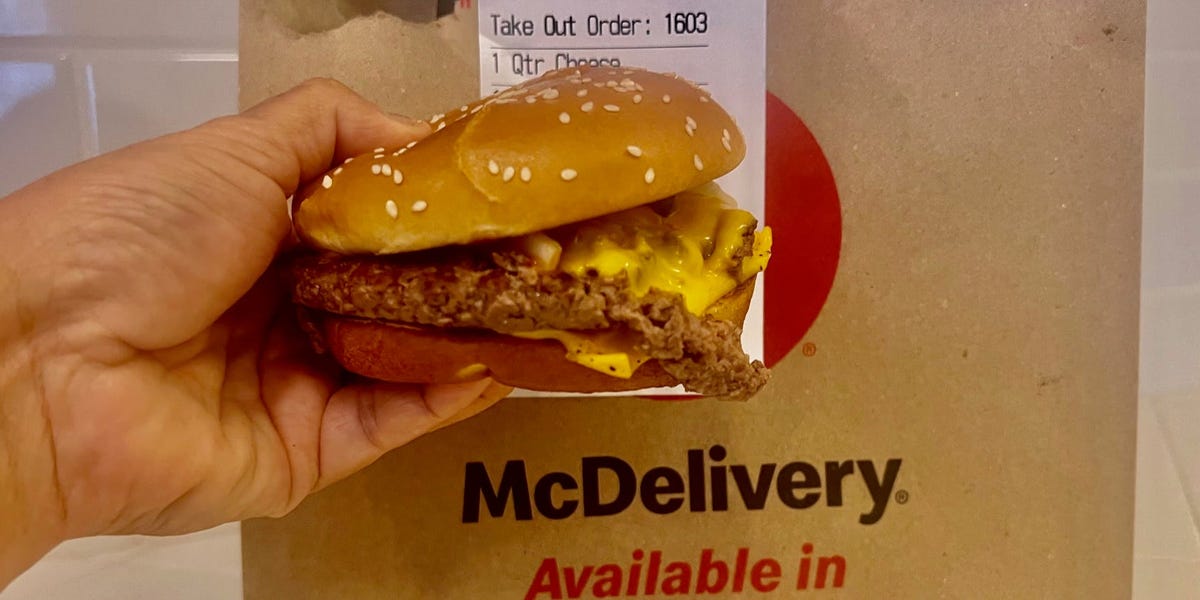- Restaurant chains have been increasing prices on delivery menus since before the pandemic.
- Insider found prices for Chipotle, Chick-fil-A, and McDonald’s were 20% to 38% higher on delivery apps.
- DoorDash said inflated menu prices are one of the delivery provider’s top customer complaints.
It’s no secret that restaurants have raised menu prices to offset food inflation and escalating employee wages over the past two years.
Chipotle has raised prices five times since June 2021, but has not increased prices in 2023. Dollar items on McDonald’s $1 $2 $3 Dollar Menu are vanishing.
While consumers are paying more for fast-food burgers and burritos at their favorite chains, what they might not realize is that they are paying even more for the same foods bought on delivery apps, as Insider found after researching prices at Chipotle, McDonald’s, and Chick-fil-A.
The prices for combo meals and entrees listed on DoorDash and Uber Eats were 20% to 38% higher compared to in-store prices. Even sides and ingredients such as guacamole and tomatoes cost more on delivery apps. The move to raise menu prices on delivery apps comes as dozens of cities across the US have placed fee caps on delivery providers to help the bottom lines of restaurants.
DoorDash and Uber Eats said restaurants, not they, set prices on their apps. And, delivery prices continue to go up despite fee caps.
At a McDonald’s in Orange, California, Insider found that a Quarter Pounder with Cheese meal cost $10.19. On DoorDash, the price is $12.23. On Uber Eats, it jumps 38% to $14.09. The price doesn’t include delivery fees, taxes, and tips.
Insider also discovered that delivery prices for the same restaurant chain can vary by location. One Chipotle restaurant listed a bowl on DoorDash for $11.50, while another one nearby priced that same bowl at $11.85.
DoorDash said it encourages restaurants to “maintain delivery menu prices that more closely reflect in-store menu prices.”
McDonald’s and Chick-fil-A declined to comment for this story.
“There is a premium associated with the delivery channel,” Chipotle told Insider, adding that its delivery prices are about 30% above in-store and order-ahead menu prices.
Here’s what I discovered researching prices at Chipotle, McDonald’s, and Chick-fil-A restaurants near my home in Orange, California.
Chipotle
At Chipotle, a chicken bowl cost $8.85 at a restaurant near Chapman University in Orange.
When I ordered that same meal on the DoorDash app, the Chipotle chicken bowl jumped to $11.50, nearly 30% more than the restaurant’s price. With service fees, taxes, and a suggested $2.50 tip, the total for delivering the chicken bowl through DoorDash was $17.89. (Note: This order came with no delivery fee. I am not a member of DashPass, which offers zero fees on delivery.)
Guacamole prices also jumped when ordering delivery. A side of guac cost $3.45 on DoorDash, compared to $2.65 in the restaurant. A side of queso blanco also increased by 30% from $2.65 in the restaurant to $3.45 on the DoorDash app.
This next order was a shocker. When I ordered delivery through the Chipotle app, the chicken bowl was the same price as on DoorDash, $11.50.
Shouldn’t Chipotle give consumers a break for ordering within its own app? This type of order, known in the industry as white-label delivery, is cheaper for Chipotle because it’s only paying DoorDash a fee to deliver food. It’s not paying DoorDash a fee to be listed on its app, or marketplace.
The delivery total from the Chipotle app was $18.37. That included a $1 delivery fee, a $2.50 suggested tip (equal to the DoorDash tip), and $3.37 in taxes and other fees.
The head-scratcher conclusion: It is more cost-effective to order delivery from DoorDash than within the Chipotle app.
Chipotle said its delivery premiums “are comparable with peers” and consumers don’t appear to be balking.
“Historically, these customers have been less sensitive to menu price markups and have an understanding that there’s a cost associated with the convenience,” the company told Insider. “Chipotle is consistently ranked high from consumers in terms of its value.”
Still, the chain has seen digital orders decrease over the past two years as a percentage of sales. In its latest quarter, digital sales represented 38% of sales. That’s down from 48.5% in the same quarter two years ago.
Lastly, I thought I was experiencing an Uber-style surge pricing strategy when I found delivery prices changing from one day to the next at Chipotle. I ordered a Chipotle chicken bowl from DoorDash on a Monday. It cost $11.50 around lunchtime. The next day, I rechecked the price. It was $11.85 on DoorDash.
But, after bringing this to the attention of Chipotle and DoorDash, they told me menu prices can vary by location.
Chipotle said my order “was placed from one location on Monday and Tuesday, you were viewing a different location with a different menu price of $11.85 as there are a variety of Chipotle locations within your range.”
McDonald’s
I compared prices on a Quarter Pounder with Cheese meal at McDonald’s and found markups ranging from 20% to 38% for delivery.
At my local restaurant, the combo meal cost $10.19. On DoorDash, the same meal cost $12.23. That’s a 20% markup. On McDelivery, delivery orders made through the chain’s app, the meal was also $12.23. McDelivery orders are fulfilled by Uber Eats.
When I went to the Uber Eats app, the same burger meal shot up 38% to $14.09.
McDonald’s did not return a request for comment.
Uber Eats told Insider that merchants set their menus and prices.
Uber Eats didn’t respond when asked if it had any policies regarding elevated pricing on the app. But, according to the Wall Street Journal, Uber Eats alerts customers in some cities that delivery menus might be priced higher than in stores.
Chick-fil-A
At Chick-fil-A, I compared prices for the traditional fried chicken sandwich.
The sandwich, with no extras, cost $5.69 in the restaurant. The price jumped nearly 30% to $7.39 on DoorDash. Adding extra ingredients costs more in the restaurant and on DoorDash.
For example, adding lettuce and tomatoes to the sandwich costs 40 cents more in the restaurant. Adding those same ingredients on DoorDash costs 50 cents more for a total of $7.89, compared to $6.09 in the restaurant.
When I asked the cashier how much they are charging for lettuce and tomato, he seemed startled and didn’t respond. A manager-type stepped in, and told me: “It’s not that much.”
Conclusion: ‘Blunt instrument’ markups are not sustainable, says one restaurant pricing expert
Premium pricing on delivery food has been around since before the pandemic. But lately, customers are starting to notice extreme price inflation – and they don’t like it, according to DoorDash.
“Marked-up menu prices are one of the top customer complaints DoorDash receives,” the delivery operator told Insider. “This is one reason – among many – why DoorDash encourages restaurant partners to maintain delivery menu prices that more closely reflect in-store menu prices.”
DoorDash said restaurants that mark up menu prices can see up to 37% fewer sales and up to 78% lower reorder rates. The data is based on a March 2023 survey of 4,500 small and medium-sized restaurants on DoorDash during a four-week period.
DoorDash said it “reserves the right to remove merchants” from its platform if they degrade the overall customer experience. That includes booting merchants who engage in extreme markups.
“This could be due to extremely poor customer ratings, poor quality metrics, or extreme levels of price inflation,” the company told Insider.
DoorDash declined to reveal how high a markup must be for a restaurant to be removed from its system.
Ashwin Kamlani, CEO of restaurant dynamic-pricing firm Juicer, said consumers are willing to pay a premium on delivery “when it’s reasonable.”
But that’s starting to change.
“The blunt instrument of 20% to 30% ‘inflation’ on delivery apps isn’t sustainable, and now, with the industry shifting to value, calculating the right offer is paramount,” said Kamlani.
His food tech startup plans to release a product next year that will show consumers how much they save when they order directly from a restaurant versus a delivery app.
When it goes live in, it should be another eye-opener for diners.
“We believe that most consumers don’t know about how much they could save by ordering direct,” Kamlani said. “And if the industry comes together to educate the consumer, it could initiate a wave of change in consumer behavior.”
Read the full article here





